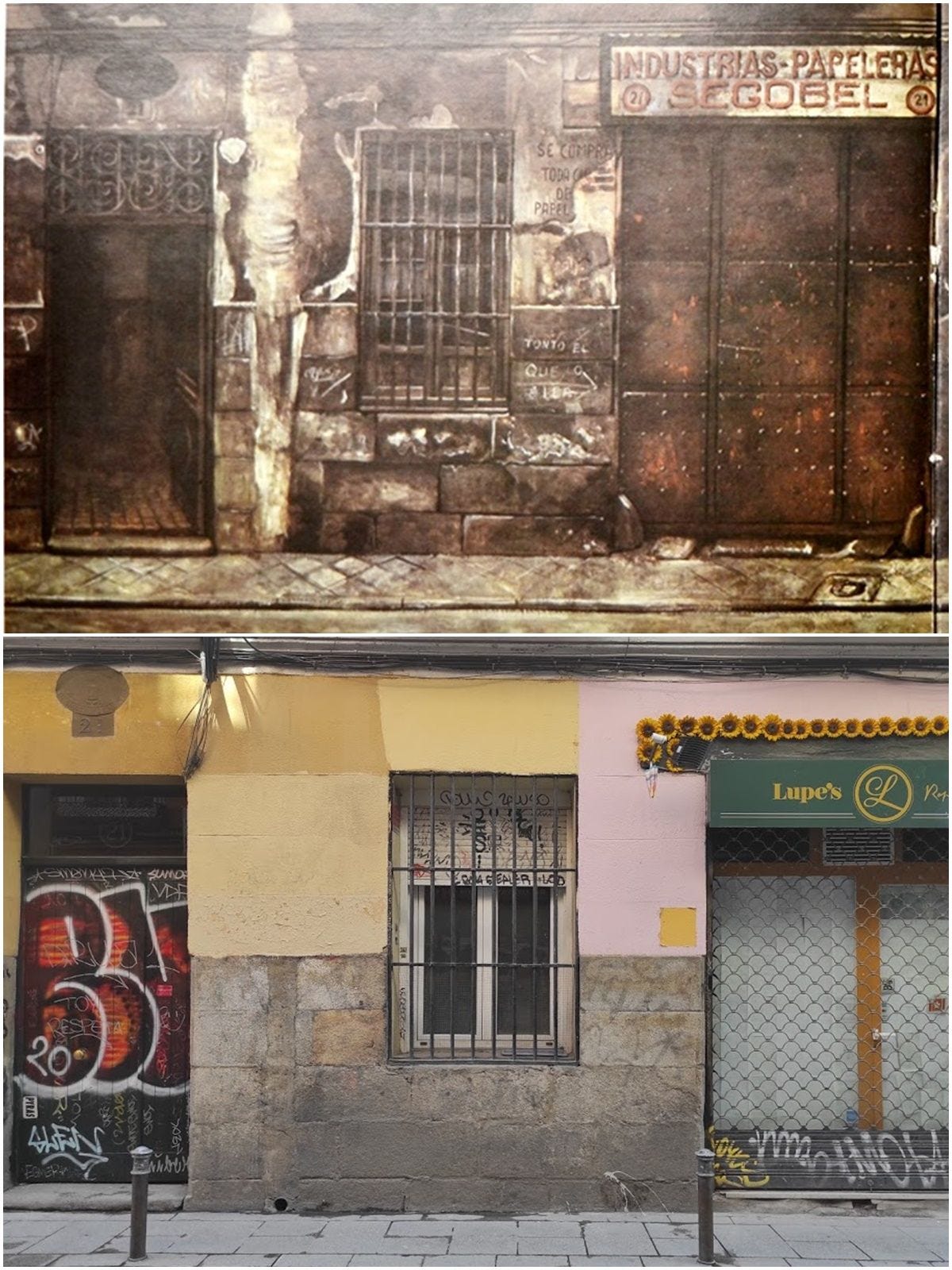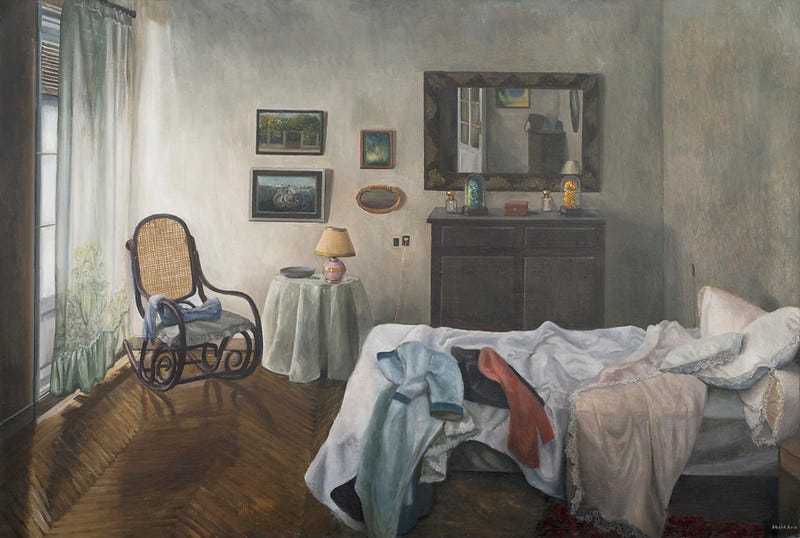A few weeks ago, I went to a (free!) art exhibition in Madrid called “El Japón en Los Ángeles: Los archivos de Amalia Avia.” I wasn’t familiar with the artist, Amalia Avia, before seeing a random ad for the show, and the paintings of Madrid caught my attention, so off I went to Sala Alcalá 31.
A majority of the subject matter of Avia’s paintings is the Spain (mostly Madrid) of the 50s to 80s, in all its derelict glory. For most of those years, the country was under tight control of the fascist dictator Francisco Franco (link for all my American friends who weren’t taught about this in school), which negatively affected the way Spain looked, acted, and progressed as a nation. To paint her Madrid, Avia turned to la vida cotidiana, or everyday life, which meant lots of portraits of old city buildings as well as household scenes.
Image credit:
https://www.flickr.com/photos/espaciosparaelarte/52273968971/in/album-72177720301165996/
The blurb on the wall of the exhibition talked about how people tend to call her work “realism” simply because she painted scenes from real life, mostly from photographs she’d taken, “never making literal copies, but sentimental translations” of her subject matter. It went on to say that her work actually has pop elements that are rarely acknowledged, and as I passed along the walls of paintings, I began to see it.
Avia painted storefronts with the graffiti covering their surfaces faithfully preserved, their hand-painted advertisements transcribed. The paintings are messy and dirty and true to life. They show the real Madrid, the Madrid we all still see today, even 30-70 years later. The childish scrawl of “TONTO EL QUE LO LEA” (“if you’re reading this, you’re stupid”) that appears on the building facade in her painting of Calle San Vicente Ferrer 21 from the 1970s could be there even now. Her work shows people watching fútbol games and gathering at small castizo (old-school) bars; it shows half-faded signs and the actual texture of these pitted, peeling buildings, still standing throughout the decades.
Image credit:
https://www.eldiario.es/madrid/somos/malasana/noticias/busca-malasana-desaparecida-pintora-amalia-avia_1_7349037.html
Image credit: https://www.flickr.com/photos/espaciosparaelarte/52274230309/in/album-72177720301165996/
I noticed that I seemed to be one of the youngest people at the exhibition. The crowd was entirely made up of elderly Spanish people, excitedly pointing things out in the paintings and talking about what Madrid was like back in the day when Avia was most active. “You know what that is?” a white-haired woman exclaimed to the person she was with. “You must remember that bar!”
I’m sure most of these older people don’t have a ton of personal, visual records of those years, seeing as cameras weren’t very accessible to the average person in the 50s, 60s, even 70s in Madrid. How strange it must be to see an old hangout you once knew, or a store, or a street scene you could’ve been part of, after not thinking about them for so long. I’ve only lived in Madrid for three years, but being able to recognize the neighborhoods Avia portrayed in her work or the familiar sight of a particular type of bar interior was comforting to me. When I think of Spanish art, I think of the long-ago greats like Goya or Velázquez, who painted royalty and battles and landscapes. I don’t think of the shuttered tavern, the ornate old-people furniture, the metro station. But that’s the Madrid I see everyday.
Image credit: https://www.flickr.com/photos/espaciosparaelarte/52274228134/in/album-72177720301165996/
The building that houses La Bobia, pictured above in 1963, is actually where I spent the first few weeks of the Covid quarantine in 2020. My friends lived in an apartment there that we visited frequently before the pandemic, so seeing it looking not so different from the way it does today was cool. (Side note: nowadays, the flow of traffic on that street runs in the opposite direction.)
It’s also interesting to think that Avia painted almost entirely from photos she’d taken. This is something not too difficult to imagine today, when I could take a photo with my phone in beautiful color, true to life, and recreate it on canvas. I could zoom in and out on each part of the picture and still see all the details clearly. My phone organizes all my photos by the date and location where they were taken, and it stores them even if my phone disappears. Avia was out in the trenches, paintings based on faded photographs, memories, and fill-in-the-blank details.
Many of Avia’s reference photos were taken and developed on black-and-white film. While painting, she’d have to reproduce them in color, which she often did in dark, dull, gloomy tones. I don’t notice those “depressing” aspects of Spain while living here, because for an American, old and decaying things are history come to life. I love seeing buildings with graffiti and holes in the facade and old signs—proof that something has happened there. Spanish people tend to cast those things to the side as just old and ugly, because they’ve always been able to see signs of their history everywhere. In New York, we have to look for a bar with an old neon sign and 70s decor (and we feel like we’re in on some big secret when we find one); here in Spain, there have always been plazas and fortresses and opera houses and walkup buildings from the 18th century. Avia portrays these parts of Spain in a refreshing way—yes, they’re objectively ugly and old, but they’re worth painting and therefore worth memorializing. How nice to see that the tabernas from the 1960s look the same way the old-school ones do today. How miraculous that Avia was able to convey all these things about Spain with the smallest of black-and-white photographs, filling in the details herself.
Image credit: https://www.flickr.com/photos/espaciosparaelarte/52274227774/in/album-72177720301165996/
The second part of the Amalia Avia archive is a collection of paintings of household objects and scenes. If we’re talking about pop art, this isn’t what you’d normally picture—there are no bright colors, no prominent brand logos, no attempts at commercialization. She paints things like a vacuum cleaner, a tool set, furniture you’d find in your abuela’s living room, but they don’t feel like still-life paintings, either.
My favorites of this series were the paintings of different people’s beds. I didn’t grow up in Spain, I don’t have family from here, but I know those beds, those rooms. These paintings almost made me feel like I was walking in on something I shouldn’t, like I was a kid sneaking into my grandma’s bedroom, portraits of dead family members silently judging me from above as, over by the window, the curtains moved slightly, startling me into running away.
Image credit:
https://www.flickr.com/photos/espaciosparaelarte/52274453375/in/album-72177720301165996/
There’s a type of video on Tiktok that’s been popular over here for a few months now, in which people show life in small-town Spain, in their pueblos. Set to Rosalía’s theme song for the Spanish Netflix series Paquita Salas, the videos give us flashes of life in “the real Spain,” as many call it: young people pouring hot coffee into a glass of ice to make iced coffee, trying not to spill; abuelos sitting on couches and smoking; a crucifix above a bed with lacy blankets on it; empty dirt fields that used to be farms; olive trees; tattered buildings. We could call that the modern-day equivalent of what Amalia Avia wanted to do—show everyday life in “the real Spain” in all its baseness and monotony, still worth romanticizing.
Con mucho amor,
Kim









